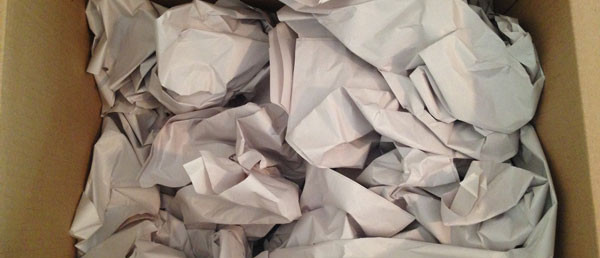
23 Jul Packing Tips from the Pros
For the last four months, I’ve been assisting a San Francisco-based organizer who specializes in moving and relocations. Often times, the moves are large and require a crew of from 2-10 organizers to assist with packing, and again with unpacking if the job is local. I have lived in over 9 states (some of them twice) and two foreign countries, so if anyone understands moving, it’s me. Or so I thought. These tips are simple, and when followed, help to create an easier moving process, especially if you are doing it on your own.
Thanks to what I’ve learned from the professionals, here are my TOP TEN PACKING TIPS FOR MOVING:
1 – Get organized BEFORE you move.
If you have the time/money, I highly recommend hiring a professional organizer to assist you with organizing your belongings before you move. If you don’t, this is something you’ll need to carve out time to do on your own. Break up the rooms into sections to make this more manageable (i.e. tackle one drawer at a time, or one section of your closet). Decide what items you want to keep, purge or donate. There’s nothing like a move to make you realize how much ‘stuff’ you have. It will absolutely inspire you to cut down on items you no longer want, use or need. You might be surprised to find out that you’ll do even more purging when packing, even if you’ve already done some in advance of the move. Getting organized before you move helps to create a more seamless, less stressful move because you know what you have, and hopefully it is all in a place that makes sense. One last piece of advice – walk through the new place and think of the new rooms here and how items from old rooms will fit in the new house. If you are moving from an apartment with no storage or garage to a place that now has storage or a garage, pack boxes for those new rooms and label them as such.
2 – Invest in good moving supplies.
This might sound obvious, but even I’ve been guilty of buying cheaper boxes because moving can be so expensive. If you’re doing the move on your own, buy new boxes if possible, or find gently used ones that appear strong and sturdy. If you’re working with a moving company, chances are supplies are included in your overall quoted price. If so, use them, even if you are doing the packing yourself. I’m not against re-using boxes (you can find many on your local list-serves or via Craigslist), but only if they are in good condition. If boxes look beat up, they will not protect your items – even clothes.
The same goes for paper. While bubble wrap can be used, paper is used by all moving companies because it’s cheaper and more reliable. When you ‘crush’ paper (by crumpling it) you change the density and it protects your items better. None of the professional jobs I have worked on have ever used styrofoam or bubble wrap – that should tell you something. Finally, invest in good packing tape (read: do not buy this from the dollar store). If it doesn’t stick well or is too thin, the box will fall apart and your items will break. Think of your moving supplies as your insurance policy – invest in good products and your stuff has a better chance of arriving to your new home in the condition it left your old one.
Bonus tip: invest in ‘dish pack’ boxes for fragile items (not just dishes) and a few wardrobe boxes for items that must be hung. Note that wardrobe boxes cannot be overpacked – the weight is usually too heavy so you can only fill it about half way, if that. If clothes can be folded, or if the move is local and you can transport clothes on hangers in your car, do so. Wardrobe boxes are awkward and heavy, and I do not recommend them unless you absolutely need them.
3 – Create a table to save your back.
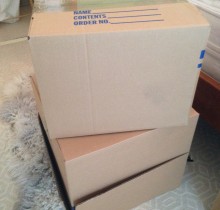
Create a ‘table’ from a large or medium box, and pack your boxes on that. This was such a simple idea but I didn’t think of it until my team leader told me about it. Bending over to pack a box really takes it’s toll even in an hour. If you have to, pack your box on the floor, but by all means protect your back by packing boxes at a level where you are not constantly bending over. Oh, and book a professional medical massage once the move is complete!
4 – Use more smaller and medium boxes.
In the theme of saving your back – it’s best to use more smaller and medium boxes because boxes can get heavy quickly! And if you are packing books, use the UHaul book box because book boxes can be extremely heavy – even when super small (note: large art or coffee table books will not fit in the book box, but most books will). Movers will also thank you for packing in smaller boxes to keep the weight down. Your box count may be higher, but trust me, you’ll prefer the smaller and medium boxes which are much easier to carry.
As a rule of thumb the majority of boxes you’ll buy will be book/small boxes. Then a good amount of medium boxes. You’ll buy fewer large and extra large boxes and fill these with bulky items (like bedding). Movers often provide wardrobe boxes on move day, but if you are doing the move on your own, be sure to invest in good ones (UHaul which has several sizes or Uline).
5 – Pack in layers.
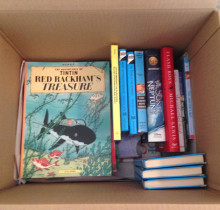
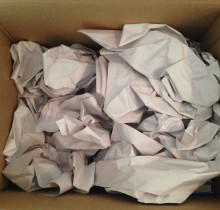
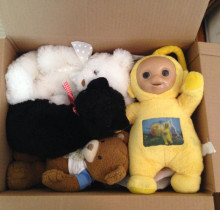
This is another place where I had a lot to learn! In order to keep your items protected, pack in layers. Here’s a great example: recently I was packing a 9 year-old boy’s room and started with his bookshelf. He had a lot of books, and the weight quickly added up in one layer of a small box, leaving a ton of extra room wasted. I didn’t want to waste that space, so I packed lighter items (stuffed animals and small action figures) on the top layer of the boxes. If it’s all going to the same room, it’s ok to mix categories in a box. The same goes for a desk or bathroom: pack heavier items at the bottom of a box, place a nice layer of ‘crush’ and then pack lighter items on the top. If you can’t find anything else to pack, fill the rest of that box with as much crush as you can. You want the box to be full – whether of items or crush – so that it’s stackable. If you leave empty space, and stack heavier boxes on top of non-full ones during transit, you might risk collapsed boxes and broken items.
6 – Protect your items.
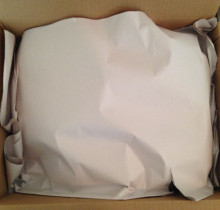
I’ll be the first to admit it, in all my moves, I never did this. Protecting your items in the box means placing a layer of paper (usually 2-3 sheets thick) at the bottom of a box, packing said box, and then placing a layer of paper over the top. This is a good thing to do because if you open a box incorrectly (this will be explained more in a future post) you could cut into something valuable. You don’t know what could happen to the top of the box, but the paper should protect it from light water damage or the box-cutter blades.
7 – Mark the paper.
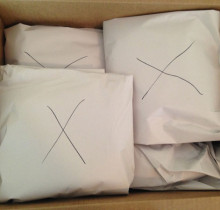
What does that mean? Let’s say you’re packing a desk, and you have a upholder of pens/pencils/highlighters. You wouldn’t wrap those individually. Take the whole stack (out of the cup), place it on your stack of paper, and roll it all up. Once it’s in a nice ‘package’ mark it with an ‘X’ so that you remember there’s something in there. This is KEY for professional organizers during a move. Often, a box is filled with so much crush, we don’t realize what is just paper and what may potentially be small objects packed inside. We make it a part of our process to flatten each piece of paper (during the unpacking process) to make sure nothing is inside, but our signal to other organizers (especially if you pack up a house but don’t unpack it on the other end) is to place a big ‘X’ on any small items that are packed up together so they don’t get mistaken or crush. This is a good habit for anyone – mark your paper! This also helps you to know if items are loose in paper so that you are more careful when you unpack it.
8 – Learn to make a ‘sausage roll.’
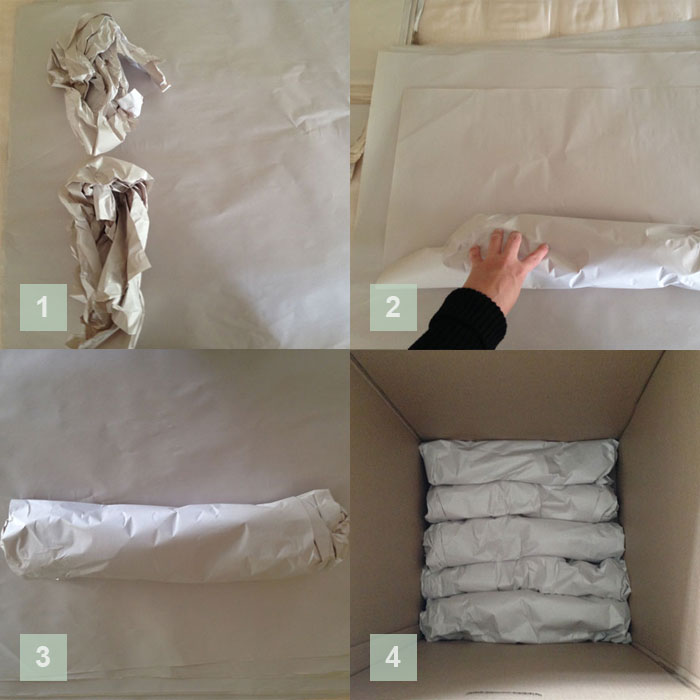 This is my favorite tip I’ve learned so far! Sausage rolls are great for lining the bottoms and tops of fragile boxes (like dish packs). It’s better than just creating a 2 to 3-inch thick layer of crush. Here’s what you do: first, crumple up two pieces of packing paper into approximately 10 inches a piece (see photo). Place these top to bottom on top of your stack of paper. Take one sheet of paper and roll this over your crumpled papers, folding the ends in as you go (see photo). Once you have created the roll, place it at the bottom of your box. Dish packs tend to take five sausage rolls. Sausage rolls are especially crucial when packing dishes, lamp shapes or other fragile items. What’s nice about sausage rolls is that you can identify them quickly (when unpacking a box), whereas with a 2 to 3-inch layer of crush, you’d have to flatten each sheet to make sure nothing is packed in there. If you remember no other tip in this list, remember how to make a sausage roll!
This is my favorite tip I’ve learned so far! Sausage rolls are great for lining the bottoms and tops of fragile boxes (like dish packs). It’s better than just creating a 2 to 3-inch thick layer of crush. Here’s what you do: first, crumple up two pieces of packing paper into approximately 10 inches a piece (see photo). Place these top to bottom on top of your stack of paper. Take one sheet of paper and roll this over your crumpled papers, folding the ends in as you go (see photo). Once you have created the roll, place it at the bottom of your box. Dish packs tend to take five sausage rolls. Sausage rolls are especially crucial when packing dishes, lamp shapes or other fragile items. What’s nice about sausage rolls is that you can identify them quickly (when unpacking a box), whereas with a 2 to 3-inch layer of crush, you’d have to flatten each sheet to make sure nothing is packed in there. If you remember no other tip in this list, remember how to make a sausage roll!
9 – Packing fragile items.
Now that we’ve covered the importance of crush paper and sausage rolls, we can discuss how to pack fragile items.
Lampshades: these must be packed individually in one box. Yes – this seems like a huge waste of space and paper, but it’s the only way to keep them safe. Pick a box that is approximately one and a half to two times the size of your lampshade. Create sausage rolls or 2 to 3-inches of crush in the bottom, place the lampshade in and then crush all around it (but not inside the shade). Then sausage roll or crush the top.
Very fragile or breakable pieces (like model boats or airplanes): treat like lampshades. Place sausage rolls at the bottom. Wrap the item in several layers of loose paper and place inside the box. Place as much crush as necessary around the item so that it does not move. Place sausage rolls or additional crush at the top of the box to keep it safe. If you need a box bigger than the one you have, tape two together to create the right size. Remember, these boxes and paper are your insurance policy that your items will not break – pack appropriately.
Fine china or dishes: pack these on their ends. Sounds crazy right? But if you pack the dishes one on top of the other like you would in a cabinet, the weight could potentially mean damage for the dishes in transit. Instead, take one dish and start to wrap it in 2 sheets of paper by folding one corner up to cover the dish. Place a second dish on the paper and fold the sides over. Depending on the size of the dish (with saucers or salad dishes you can pack more; with dinner plates stick to two max) you can pack multiples in the two sheets of packing paper. Once you’ve wrapped your dishes in the paper, place on their sides (as if you were placing in a dishwasher) with crush or sausage rolls around the sides of the box for extra protection. Remember, these will get heavy so use one to two layers maximum of dishes, with lots of crush or sausage rolls in-between.
Barware: treat this similarly to fine china or dishes, but pack on their ends. Wrap each wine glass or bar glass in two sheets of paper, carefully stuffing extra paper at the top into the glass (do not force or you could break the glass). Pack these as if you were stacking them in a cabinet (opposite of the dishes), next to each other with a good layer of crush around the edges. I recommend doing a few layers in a larger box, provided the box doesn’t get too heavy.
Another tip is packing only one layer of dishes or barware in a small box (taping it shut; labeling it) then placing it on top of some sausage rolls in a larger dish pack, adding crush on top and then packing more fragile kitchen items. Make sure to mark all these boxes as FRAGILE which brings me to my last and final tip…
10 – Label your boxes.
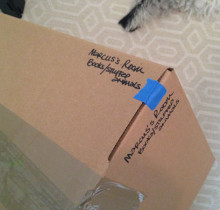
Again, this seems pretty self explanatory, but there is a right way to label a box. Clearly print in the upper right hand corner the name of the room where the box will be unpacked, and below that write a few examples of the contents. If the box is fragile, write that in big capital letters (I like to use a red marker so it really stands out). Then make sure to write all of this on the side of the box in the upper right hand corner (see image). Take this one step further and color coordinate your boxes if necessary. We do this if we are packing items to go to multiple places: new house (blue tape), storage (red tape), donation (green tape), vacation home (orange tape), estate sale (yellow tape), etc. If these designations do not apply to you, you can use different colored post-its, labels, stickers or colored markers to designate different rooms. Place a note in each room of the new home with that color designation so the movers know where to place the boxes.
Hopefully you find these tips helpful. Soon I will post a follow up to this blog about the TOP TEN UNPACKING TIPS FOR MOVING – stay tuned!
Here is a *FREE* printable with all these tips: Top 10 Packing Tips for a Successful Move
And another to use during your move: Moving Checklist – Pack & Take with You





Hazel Thornton
Posted at 13:46h, 04 AugustThese are timely tips for me and my newest clients! Lucky for me, they are only moving across town. I will share both your packing and unpacking posts with them!
Lauren Mang
Posted at 03:52h, 05 AugustThanks Hazel! I’m glad you found them helpful.
Ranya Anabtawi
Posted at 00:49h, 04 SeptemberI love the sausage roll! I’m going to try that.
Lauren Mang
Posted at 01:55h, 04 SeptemberIt’s a game changer! I can even show you how to make one in person. There might even be some in the “crush” box I have for you.
Pingback:INTERVIEW: Tips From An Organizing Expert On How To Move Responsibly & Efficiently -
Posted at 13:25h, 07 July[…] “Packing Tips From The Pros” […]